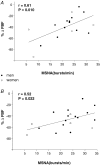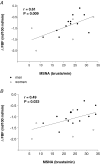Vascular adrenergic responsiveness is inversely related to tonic activity of sympathetic vasoconstrictor nerves in humans
- PMID: 16513672
- PMCID: PMC1780018
- DOI: 10.1113/jphysiol.2005.104075
Vascular adrenergic responsiveness is inversely related to tonic activity of sympathetic vasoconstrictor nerves in humans
Abstract
In humans, sympathetic nerve activity (SNA) at rest can vary several-fold among normotensive individuals with similar blood pressures. We recently showed that a balance exists between SNA and cardiac output, which may contribute to the maintenance of normal blood pressures over the range of resting SNA levels. In the present studies, we assessed whether variability in vascular adrenergic responsiveness has a role in this balance. We tested the hypothesis that forearm vascular responses to noradrenaline (NA) and tyramine (TYR) are related to SNA such that individuals with lower resting SNA have greater adrenergic responsiveness, and vice-versa. We measured multifibre muscle SNA (MSNA; microneurography), arterial pressure (brachial catheter) and forearm blood flow (plethysmography) in 19 healthy subjects at baseline and during intrabrachial infusions of NA and TYR. Resting MSNA ranged from 6 to 34 bursts min(-1), and was inversely related to vasoconstrictor responsiveness to both NA (r = 0.61, P = 0.01) and TYR (r = 0.52, P = 0.02), such that subjects with lower resting MSNA were more responsive to NA and TYR. We conclude that interindividual variability in vascular adrenergic responsiveness contributes to the balance of factors that maintain normal blood pressure in individuals with differing levels of sympathetic neural activity. Further understanding of this balance may have important implications for our understanding of the pathophysiology of hypertension.
Figures




References
-
- Charkoudian N. Influences of female reproductive hormones on sympathetic control of the circulation in humans. Clin Auton Res. 2001;11:295–301. - PubMed
-
- Davy KP, Seals DR, Tanaka H. Augmented cardiopulmonary and integrative sympathetic baroreflexes but attenuated peripheral vasoconstriction with age. Hypertension. 1998a;32:298–304. - PubMed
-
- Davy KP, Tanaka H, Andros EA, Gerber JG, Seals DR. Influence of age on arterial baroreflex inhibition of sympathetic nerve activity in healthy adult humans. Am J Physiol. 1998b;275:H1768–1772. - PubMed
Publication types
MeSH terms
Substances
Grants and funding
LinkOut - more resources
Full Text Sources
Research Materials
Miscellaneous

